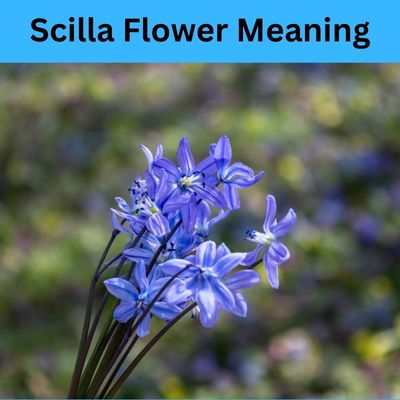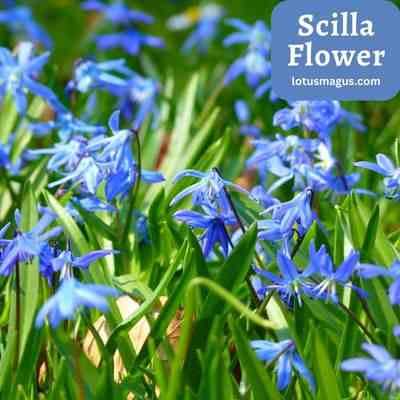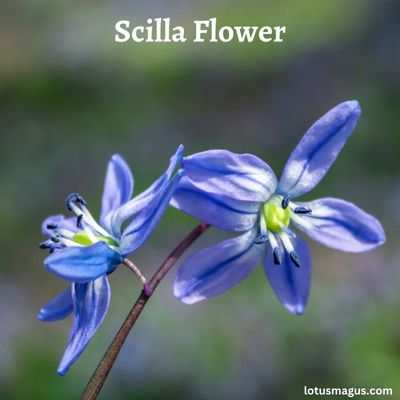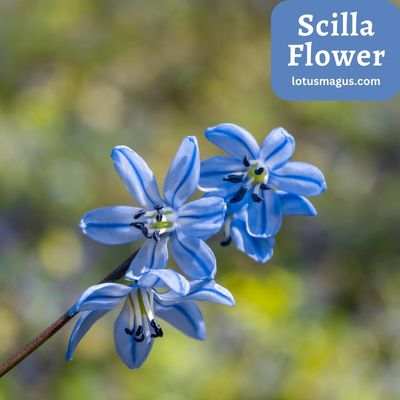Flowers are known for their ability to convey feelings, emotions, and messages. The Scilla flower, also known as Squill, is a breathtaking blue flower that has been celebrated for centuries for its beauty and rich symbolism. Beyond its vibrant color and delicate petals, the Scilla flower holds a fascinating history and meaning that is worth exploring. In this blog post, we’ll delve into the world of Scilla flower meaning and symbolism, and uncover the hidden stories and legends behind this enchanting flower.
Scilla Flower Meaning : Scilla Flower is a eurasian blue flower that symbolises loyalty, love, inspirtation, serenity, peace, constancy, fidelity and more. Greek word “Scilla” had a meaning to harm someone due to scilla’s species toxic nature in European. In modern times, the Scilla flower is often used as a symbol of hope and new beginnings. Its delicate beauty and ability to thrive in harsh conditions make it a popular choice for gardens and outdoor spaces, where it can bring a sense of tranquility and renewal.
Scilla flowers typically emerge from the snow to greet spring. These lovely blue flowers attract pollinators and give brightness to gardens and landscapes. When planted in quantity, Scilla’s tiny blooms on long stalks provide a lovely spectacle. Gardeners love Scilla’s capacity to naturalize and proliferate year after year, producing a sea of blue.
With its thin green leaves and exquisite blue blossoms, the Scilla plant has been used medicinally for centuries. Its bulb includes chemicals that alleviate headaches, coughs, and heart disorders. Traditional medicine uses Scilla to produce vomiting and diuretic. Scilla is a fascinating plant with a rich history.
Scilla flowers are beautiful and ecologically beneficial. Early-season pollinators like bees and butterflies consume Scilla. These insects start their spring activity with nectar from these little blue blossoms. Several ecosystems depend on the Scilla plant, which hosts various moths and butterflies.
Poets, artists, and musicians have been inspired by Scilla flowers for generations. Paintings, poetry, and songs have depicted its exquisite blue petals and graceful appearance. Myths and traditions about the Scilla range from rebirth and fresh beginnings to sorrow and unrequited love. The Scilla still inspires artists and authors worldwide.
Scilla flowers are low-maintenance, colorful garden plants. Once established, these hardy plants are simple to care for. They thrive in well-drained soil and full to partial light, making them ideal for many gardens and landscapes. The Scilla plant is a superb naturalizer, growing each year to produce lovely blue flowers.

| Specification | Description |
|---|---|
| Scientific Name | Scilla |
| Common Name | Squill |
| Family | Asparagaceae |
| Genus | Scilla |
| Species | Scilla bifolia |
| Flower Color | Blue |
| Bloom Time | Late winter to early spring |
| Flower Size | 1 inch (2.5 cm) |
| Plant Height | 4-6 inches (10-15 cm) |
| Plant Width | 2-3 inches (5-7.5 cm) |
| Sunlight | Full to partial sun |
| Soil Type | Well-drained |
| Soil pH | Neutral |
| Hardiness Zones | 3-9 |
| Native Range | Europe, western Asia, North Africa |
| Uses | Ornamental, medicinal |
| Other Names | Two-leaf squill, Alpine squill, Scilla sibirica |
What is Scilla Flower?
Scilla Flower, a gorgeous bulb-forming perennial herbaceous plant in the Asparagaceae subfamily Scilloideae, is popular. The genus Scilla includes 30–80 species of early spring-blooming bulbs with delicate, colorful blooms. Hyacinthoides hispanica is the scientific name for Scilla campanulata, often known as wood hyacinths or Spanish bluebells.
Scilla plants have lovely, tiny, bell-shaped or starry blooms on slender 3-6 inch stalks (7-15 cm). Scilla flowers are beautiful and lively in blue and white. These tiny bulbs cover the ground in April, making them excellent for many landscapes and gardens.
Scilla flowers have six flaring blue petals and a darker blue stripe through the middle. Its attractiveness is enhanced by 6 white stamens with dark blue ends. Spring scilla flowers beautify gardens and landscapes.
Plant Scilla Flowers in early autumn in well-drained soil. These early-blooming bulbs may be planted in bunches to create a lovely flower carpet. Scilla Flowers beautify any outdoor area and are simple to maintain.
Scilla Flower history
Scilla Flower symbolised optimism and regeneration in ancient Greece. Scilla Flowers were employed in Greek religious rites and thought to cure. The plant was named after Scylla, the Ancient sea nymph Circe turned into a sea monster.
Scilla Flowers were used to cure asthma and TB in medieval times. Cough syrups and medicines used bulbs to soothe the respiratory system.
Europe favored Scilla Flowers as ornamentals throughout the Renaissance. They decorated parks and gardens from gardens. Botanists discovered new Scilla Flower species and varieties in the 18th century.
Scilla Flower meaning and symbolism
Scilla flowers, with their delicate bell-shaped blossoms and brilliant hues, have been adored and cherished worldwide for generations. These flowers symbolize persistence and enduring dedication due to their hardiness. They are presented to show profound affection and celebrate long-term partnerships.
Scilla Flowers symbolize loyalty, dependability, and constancy. Scilla Flowers signify the value of these attributes in personal and professional relationships.
Scilla Flowers symbolize optimism and fresh beginnings. These flowers symbolize spring and development. Its joyful hues and delicate, bell-shaped blossoms remind us that even in bad times, there is hope for a better future.
Some cultures equate Scilla Flowers with spiritual progress and enlightenment. These flowers are said to help us access our intuition and higher selves. They encourage tranquility, quiet, and centeredness in meditation and other spiritual pursuits.
The Scilla Flower was connected with Aphrodite and love in ancient Greece. The Scilla Flower, connected with Venus in Roman mythology, was used in love potions and other amorous rites. Scilla flowers are still used in bridal bouquets and other romantic situations to signify love and passion.
The Scilla Flower, known as “Mary’s Tears” in Christianity, symbolizes Mary’s sadness at Jesus’ crucifixion. The Scilla Flower is often used at funerals and other sad events because of its affinity with grief.
Scilla Flowers symbolize beauty and elegance despite their varied meanings. Its delicate petals and brilliant colors remind us that even amid darkness and adversity, there is always something to be thankful for and celebrate.
Scilla Flowers are culturally significant as well as symbolic. Scilla Flowers are highlighted at Japan’s annual Cherry Blossom Festival. Scilla flowers symbolize regeneration and development in Iran and are used to commemorate the Persian New Year.
Traditional medicine has treated respiratory, cardiac, and stomach difficulties using Scilla plants. While utilizing Scilla medicinally, be aware that certain species are hazardous if consumed.
Scilla Flower in popular culture
Literature, art, and music have mentioned scilla flowers.
William Wordsworth’s poem “Lines Composed in Early Spring” mentions “blue and white Scilla blooms” in the woods. “Sense and Sensibility” and “The House of Mirth” reference the flowers.
Scilla flowers have appeared in many artworks. “Flowers in a Blue Vase” by Vincent van Gogh depicts a Scilla flower vase on a table. The Amsterdam Van Gogh Museum has the artwork.
Music includes scilla blossoms. “Where the Blue of the Night (Meets the Gold of the Day)” by Bing Crosby begins with “scilla blossoms” and “perfume rare” from a garden. “The Garden” by Rush mentions “beds of scilla” and “fields of azure.”
Scilla flowers are very important in other cultures and customs. Scylla, a sea monster in Greek mythology, terrified sailors and was changed into a rock at the Strait of Messina. Scilla flowers, considered dangerous and deadly, bloomed from her blood.
Some cultures think Scilla blossoms are therapeutic. Traditional medicine has treated respiratory, arthritic, and skin issues using Scilla bulbs.
Gardeners grow Scilla species like S. siberica and section Chionodoxa for their early spring blossoms.
S. siberica—Siberian squill—is a popular Scilla species. Russian-born and grown since 1796. Siberian squill grows well in partial sunlight and forms bulbs. Its exquisite blue-violet spring blossoms are commonly planted. Bell-shaped blooms on slender 3-6 inch stalks beautify any garden.
Spring squill, or Scilla verna, flowers early in April. A tiny, low-growing plant from Western Europe, it blooms blue-violet in April. Little, star-shaped S. verna blooms emerge before the leaves.
Scilla flowers are symbolic. Scylla, a sea nymph transformed into a monster by Circe, inspired the name Scilla. When Scylla was converted, the Scilla flower grew. Scylla represents nature’s wrath in Greek mythology.
Scilla flowers indicate tenacity, fidelity, loyalty, trustworthiness, faithfulness, and constancy. Scilla flowers blossom early in spring, even in cold temperatures. As it can survive winter and blossom magnificently in April, the flower symbolizes persistence and endurance.
Scilla flowers are symbolic and therapeutic. Certain Scilla bulbs were employed as diuretics and respiratory remedies, such as asthma and bronchitis. Scilla is poisonous and should not be used medicinally.
Scilla Flower physical appearance
Scillas are attractive blooming plants with tiny, bell-shaped or starry blooms on slender, 3-6 inch (7-15 cm) stalks.
The intensely colored blossoms are blue or white. Each flower is about 1 inch wide, with 6 flaring blue petals and 6 white stamens with dark blue ends.
Scillas are admired for their spring beauty. Early autumn planting in well-drained soil produces dark green, grass-like leaves. Scillas’ elegant, gently drooping blossoms on arching stems are striking.
Scilla Flower habitat
Scilla flowers grow in many environments. They inhabit forests, subalpine meadows, and seashores throughout Europe, Africa, Eurasia, southwest Asia, and the Middle East. Australia, New Zealand, and North America have also naturalized certain species.
These spring-blooming deciduous forest flowers may grow in disturbed grassy areas, along railways, and in flower gardens. They thrive in open woodlands, roadsides, and gardens because they like part shade and wet soil. Scilla flowers may beautify any landscape, native or naturalized.
Scilla Flower care and maintenance

Scilla flowers offer appeal to any garden with its bell-shaped or starry blossoms in brilliant blue, pink, and white. For beginners or busy gardeners, these spring-blooming plants are low-maintenance.
Scilla flower care:
- Soil and Watering: Scilla flowers need well-drained, slightly acidic to neutral soil. Don’t overwater them—they want wet but well-drained soil. Keep the soil wet and water the plants frequently, particularly during growth. To minimize waterlogging, decrease irrigation during dormancy.
- Scilla flowers like moderate shade to full sun. To avoid the heat, they may need midday shade. In warmer summers, the plants need wet soil and shade.
- Scilla flowers need little fertilizer. If you wish to increase them, apply a balanced fertilizer to the soil in early spring when new growth starts.
- Pruning: Remove wasted Scilla flowers. This will boost plant growth and health. Dead or damaged foliage may also be pruned.
- Scilla flowers withstand pests and diseases. Waterlogged soil or insufficient drainage may cause bulb rot. Avoid overwatering and ensure well-draining soil to prevent bulb rot.
- Fall bulb division propagates scilla blooms. To keep plants strong, do this every three to four years.
Scilla flower care is simple. These plants will blossom every year if grown properly. Provide enough water and sunshine, prevent over-fertilizing, and cut wasted flowers and damaged foliage. With a little care, Scilla flowers will flourish and offer delight to your garden for years.
Scilla Flower benefits

Squill plant benefits:
- Squill treats respiratory disorders such bronchitis, coughing, and congestion. Squill may relieve respiratory problems by expectorating and bronchodilating.
- Squill may enhance circulation by inhibiting platelet aggregation, according to a PubMed research.
- Squill may fight germs and fungus due to its antibacterial characteristics. It might treat infections naturally.
- Due to its pesticidal properties, squill has been employed as an insecticide. It controls rats, insects, and fish naturally.
- Squill may promote apoptosis (cell death) in cancer cells, according to a Drugs.com research. This advantage needs more study.
Although these advantages are encouraging, further study is required to completely understand the effects of squill on the human body and discover the best amounts and forms for ingestion. Before taking squill medicinally, see a doctor, as with any natural medicine.
https://www.rxlist.com/squill/supplements.htm
https://pubmed.ncbi.nlm.nih.gov/30686259/
https://www.drugs.com/npp/squill.html
Scilla Flower drawbacks
These are Scilla flower drawbacks:
- Extremely invasive: Scilla flowers, especially the Siberian type, may push out native plants, according to Accent Natural. They produce thick colonies and spread quickly, making it hard for other plants to grow nearby.
- Hazardous to dogs and humans: Scilla blossoms are not harmful if swallowed in tiny quantities, but they may cause skin irritation if touched. Scilla bulbs and leaves contain poisonous chemicals that may kill cats and dogs if swallowed in large quantities.
- Possibility for inadvertent introduction: According to Gardensenses, Scilla flowers are sometimes offered as bulbs for autumn planting and may be mistakenly brought into new locations where they may become invasive. Self-seeding flowers increase the possibility of invasion.
- May replace native species: Scilla flowers can outcompete and displace native plant species in natural regions, diminishing biodiversity and environmental balance.
Scilla flowers are lovely and bring color to gardens and landscapes, but if not handled correctly, they may affect natural ecosystems. It’s crucial to know the risks of growing Scilla flowers and to stop their spread if they’re already there.
Scilla Flower uses

- A to Z Flowers says Scilla flowers are popular ornamentals because of their blue, pink, or white blossoms. They offer color and charm to gardens, borders, and rockeries.
- Traditional medicine has employed Scilla plant-derived squill for ages. Herb Wisdom claims it treats asthma, bronchitis, and edema with its diuretic, expectorant, and heart stimulating qualities.
- Natural dye: Scilla siberica bulbs produce a blue dye. LovetoKnow Garden suggests boiling the bulbs and using the juice to color clothes.
- Bees and butterflies feed on scilla nectar. Planting Scilla flowers in your yard helps pollinators and the ecology.
Scilla flowers are attractive, therapeutic, and pollinator-friendly. Yet, Scilla plants’ invasiveness and pet toxicity make them risky.
Scilla Flower interesting facts
Here are some fascinating facts about Scilla flower:
- Scilla flower, an Asparagaceae, is endemic to the Mediterranean but now grows worldwide.
- “Scilla” derives from the Greek word “skilla,” meaning “sea onion,” since the plant was found around the Mediterranean Sea and its bulbs resembled onions.
- Scilla flowers are little bell-shaped blue, pink, and white blooms. Each stalk may hold six spring blossoms.
- Bees pollinate scilla flowers, which generate nectar for numerous insects.
- Scilla flowers are simple to cultivate and popular garden and park ornamentals. They look wonderful in rock gardens when planted in groupings.
- Scilla blooms have shorter stalks and more delicate blossoms than bluebells.
Several cultures utilize Scilla flowers to cure headaches and respiratory diseases. - Several cosmetics include scilla flowers for their hydrating and skin-soothing effects.
Scilla flowers are poisonous and induce vomiting and diarrhea in people and animals. Hence, keep Scilla flowers away from children and dogs. - Scilla flowers are invasive in certain areas and may spread swiftly. While planting Scilla flowers, take careful not to disturb the habitat.
Scilla Flower superstitions
For generations, the Siberian squill (Scilla flower) has been superstitious. Superstitious people associate this flower with witches and other bad entities. Many were afraid to walk on the flowers for fear of ill luck.
Greek mythology inspired the flower’s name. Scylla, a sea monster, inhabited a small passage opposite Charybdis. This may have led to the flower’s bad omen reputation.
The exquisite Scilla flower is loved for its bright blue color and superstitions. The flower has been used medicinally and as a symbol of hope and rejuvenation in many civilizations.
Scilla Flower symbolism
Scilla flowers symbolize optimism, rejuvenation, and rebirth.
Anciently, the Scilla flower symbolized love and beauty and was connected with Venus. After being vanquished by Circe, the sea-monster Scylla became the flower. The plant, thought to have flourished where Scylla was changed, symbolized metamorphosis and rejuvenation.
Christian Scilla flowers signify resurrection hope. The plant’s capacity to blossom in early spring, even with snow on the ground, symbolizes rebirth and rejuvenation. The petals’ blue hue depicts the celestial realm. In Christian art, the Virgin Mary wears blue garments, like the Scilla flower.
Eastern traditions equate the Scilla flower with spring and rebirth. During Chinese New Year, Scilla flowers are presented as gifts to promote luck and wealth. The flower symbolizes spring and the cherry blossom festival in Japan.
Modern Scilla flowers symbolize optimism and fresh beginnings. Its delicate beauty and capacity to survive hard circumstances make it a popular option for gardens and outdoor settings, where it may provide peace and regeneration. In art and literature, it symbolizes human perseverance and strength.
Scilla Flower spiritual meaning
Siberian Squill, or Scilla, is a potent emblem of spiritual development and change. For generations, this exquisite blossom has been employed as a spiritual energy source.
Venus, goddess of love, beauty, and fertility, was connected with the Scilla flower. In love charms and rituals, the flower attracted love, passion, and affection. After being vanquished by Circe, the sea-monster Scylla became the Scilla flower. Scylla becoming the Scilla flower symbolized spiritual regeneration.
Christian Scilla flowers symbolize resurrection and fresh life. Its exquisite blue petals signify the celestial realm, and its capacity to blossom early in spring, even under adverse circumstances, symbolizes the human spirit’s endurance. In Christian art, the Virgin Mary wears blue garments, like the Scilla flower.
Eastern spirituality associates the Scilla flower with the throat chakra, which controls speech, self-expression, and creativity. The throat chakra’s strength and fragility are symbolized by the flower’s blue hue and delicate petals. In meditation and spiritual activities, the Scilla flower balances and activates the throat chakra, encouraging clarity, creativity, and spiritual progress.
The Scilla flower symbolizes spiritual enlightenment and development in contemporary spirituality. Its delicate beauty and capacity to survive difficult circumstances symbolize the human spirit’s ability to overcome obstacles and evolve. Spiritual traditions employ the Scilla flower to heal, clarify, and expand.
Scilla Flower cultural significance
Siberian Squill, sometimes known as Scilla, has been utilized in many cultural traditions. Several civilizations use it for beautiful arrangements, gardens, and traditional events because of its lovely blue-purple petals.
Venus, goddess of love, beauty, and fertility, was connected with the Scilla flower in Grecian and Roman civilizations. Love charms and rituals employ it to attract love. After defeat by Circe, the sea-monster Scylla became the flower. Scylla becoming the Scilla flower symbolized regeneration and rejuvenation.
Christian Scilla flowers symbolize resurrection and fresh life. The flower’s blue petals symbolize the celestial realm, and its capacity to blossom early in spring under hard circumstances symbolizes the human spirit’s endurance. In Christian art, the Virgin Mary wears blue garments, like the Scilla flower.
Eastern traditions equate the Scilla flower with spring and rebirth. During Chinese New Year, Scilla flowers are presented as gifts to promote luck and wealth. The flower symbolizes spring and the cherry blossom festival in Japan.
The Scilla flower symbolizes love and fresh beginnings in contemporary weddings and other events. Its delicate beauty and brilliant blue hue make it attractive for flower arrangements and bouquets. Easter, Passover, and the Persian New Year utilize Scilla flowers.
Scilla Flower in art
Painting, sculpture, and photography have depicted the Scilla flower throughout history. In Greek and Roman art, the Scilla flower symbolized love, beauty, and fertility.
Scilla Flower in literature
The sea-monster Scylla is related with the Scilla flower in Greek mythology. In Romantic literature, the Scilla flower symbolizes love, regeneration, and beauty.
Scilla Flower in film and television
In movies and TV programs, the Scilla flower symbolizes love, hope, and fresh beginnings. In “The Secret Garden” and “Downton Abbey,” the Scilla flower symbolizes the garden’s regeneration and restoration.
Scilla Flower in music
In lyrics and music, the Scilla flower symbolizes love, beauty, and rejuvenation. In Dr. Octagon’s “Blue Flowers,” the Scilla flower symbolizes nature’s beauty and mystery. In the opera “Daphne” by Richard Strauss, the Scilla flower symbolizes metamorphosis and rejuvenation.
Conclusion
In conclusion, the Scilla flower is a true gem among flowers with its stunning blue color and captivating symbolism. Its association with sincerity, humility, transformation, and adaptability has been passed down through history, and it continues to hold deep meaning and value today. Whether you’re a lover of flowers or looking for a meaningful gift, the Scilla flower is a fantastic choice that is sure to impress. So take a moment to appreciate the beauty and symbolism of the Scilla flower, and let it inspire you to live a more sincere, humble, and adaptable life.
Sweet Pea Flower Meaning And Symbolism – Know Everything
Tiger Lily Meaning: Understanding the Secret Language of Flowers
